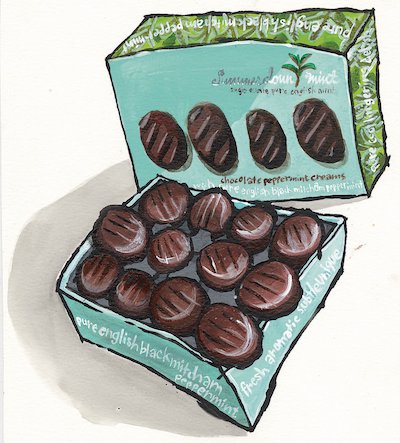1. Really good chocolate.
It probably comes as no surprise that the first step to making a really good box of chocolates is to use really high quality chocolate. Here are a few ways you can suss out quality, without an advanced chocolate degree.
Look. Good chocolate is glossy. Avoid any chocolates that are dull or dusty. The chocolate likely bloomed, meaning that the crystalline structure of the chocolate has gone out of whack due to storage issues. This happens to all chocolate eventually, so if you have good chocolate it’s best to eat it within a few months or so. After chocolate blooms it’s not unsafe to eat, but it has a gritty, dry texture and the flavor is diminished.
Texture. Good chocolate has a nice snap to it—especially dark chocolate. Cheaper chocolate is waxier. It bends before it breaks. (You can try an experiment to see this for yourself: get a good, bean-to-bar chocolate bar and a Hershey’s bar, and try breaking off a square of each. Pay attention: how does each chocolate feel? How does it sound?) After that initial snap, better chocolate should melt evenly on your tongue. By contrast, poorer quality chocolate often feels sticky or tacky in your mouth.
Taste. Most important of all, good chocolate will have a nuanced flavor. It should complement the flavor of the fillings, and the flavor should last in your mouth for a long, long time.
2. Really good filling(s).
What you put inside of a chocolate bonbon is just as important as the chocolate itself. Sometimes, that means focusing on just one filling. Many start with a single extraordinary local ingredient and covered it in chocolate. That’s not to say you can’t find good boxes of chocolates that have mixed flavors—a few of my favorite chocolatiers making great assortments are J. Patrice, Chocolat Moderne, and Bon Bon Bon. But when you have something really special, like the extraordinarily aromatic citrus of Calabria in southern Italy or the notably sweet and tender figs of western Spain, a coating of good chocolate can make them swoon-worthy.
3. Nothing else.
It’s always a good bet to look at the ingredient list when you’re evaluating any food. Boxes of chocolate are no exception. Artificial ingredients like vanillin are suspect, as are and any unpronounceable ingredients. One exception is soy lecithin, which is widely used by excellent chocolatiers in very small amounts to help the chocolate keep a smooth texture. You generally want to avoid added fats, too, though you’ll want to make an exception if there’s a cookie or caramel component to a filling where butter may be in play.

